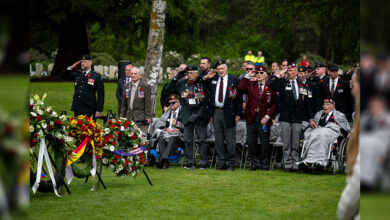History
February 15th marks 56th anniversary of our Maple Leaf
Above image of sailor, flag and ship courtesy of the Canadian Armed Forces.
This year marks the 56th anniversary of Canada’s flag and 25th anniversary of National Flag of Canada Day. The 15th was chosen to commemorate the first time the Maple Leaf flew as Canada’s national flag.
Canada’s flag, as we have come to know and love, the Maple Leaf was raised for the first time on Parliament Hill on February 15, 1965 and 31 years later, in 1996, National Flag of Canada Day was made official.
The journey to the final decision of Canada’s flag was not an easy process, explained Dr. Xavier Gélinas, Curator, Political History for the Museum of History.
The Canadian Flag or the Maple Leaf Flag, was decided by a vote. A joint committee of the Senate and House of Commons voted for the present flag back in 1964. The final design was taken up by parliament and approved by a royal proclamation after months of debate.
“It was an epic battle, and entire chapters and books have been written about the process. Not so much about the actual flag itself or the design of the flag, but about the very torturous process in which the design was finally reached. The final act of the drama takes place between the spring of 1964 and the last days of December 1964. The idea that Canada’s truly distinct national flag had been brewing and simmering with various intensities of heat since the early 20th century,” said Gélinas.
At the time of New France, two flags held national status: The Royal Union Flag (Union Jack) and the Red Ensign.

Canada was flying the Red Ensign in 1870. In 1892, merchant vessels registered in Canada flew the Red Ensign with only the four original provinces represented.
The Union Flag also flew on land at this time. In 1945, the Red Ensign was raised on federal buildings in Canada until the country found an official flag.
Initially, the idea to change the flag came from French Canadians because the flag the government used was deemed too closely attached to Britain and Canada’s colonial heritage.
French-speaking Canadians never liked the Canadian Ensign because it was a reminder of the former defeat in the Plains of Abraham.

In 1925, Prime Minister William Lyon Mackenzie King proposed the idea of a new national flag. He backed off after his proposal was met with protest against any attack on the Union Jack. He tried and failed again in 1945 with a joint committee of the Senate and House of Commons.
In the sixties, there was a general modernist trend, not just in Canada but also throughout the world. There was a general tendency to shake up and dust off old traditions.
Hence, the new flag design presented by King, was a symbol showing that, while Canada had respect and gratitude for their British heritage, it was time to show Canada had transcended.
“It was one of the few times Canadians got emotional over a public policy issue. Canadians are known and respected for being incremental reformists, and Canadians have always prided themselves on slow, gradual organic evolution with adjustments with trials and errors,” Dr. Gélinas informed.
Lester B. Pearson started the flag discussion again in 1960. A growing separatist movement in Quebec was raging and making it difficult to see unity in Canada at the time.
“French Canadians were in the middle of their own identity turmoil and questioning. So it just added to the intensity of the debates,” said Gélinas.
A flag design was presented to Pearson by heraldic advisor Alan B. Beddoe, in 1964 and in June 1964, the design was presented to parliament.
All parties knew Canada needed a flag, but they couldn’t agree on a design. John Diefenbaker insisted the flag should honour Canada’s British roots by including the Union Jack. Pearson presented a design that was free of colonial association and represented unity: the Pearson Pennant.

“The design of the Pennant was ridiculed by some, but the fierce debates that took place for eight months did not center on the actual design and covering of the Pearson Pennant. The debates centered on whether it was indeed time or not to have an entirely new flag for Canada,” Dr. Gélinas added.
Pearson appointed an all-party committee after he realized the idea of a new flag couldn’t be taken up in parliament. They held meetings and reviewed thousands of designs submitted by the public over the course of six months. Over 2,000 design ideas were submitted.
The final contenders were the Pearson Pennant, designed by Alan Beddoe, and the single-leaf flag, designed primarily by George Stanley.

The single leaf design was born out of Kingston, Ontario, as the design derives straight from the Royal Military College of Canada flag. It is meant to represent the simplest and purest embodiment of Canadian unity.
On October 22, 1964, the voting commenced, and this was considered the event of the year for Canada. The single leaf won the vote, but the debate in the House lasted six more weeks.
Senate approval took place on December 17, 1964, and Queen Elizabeth II signed the royal proclamation on January 28, 1965. The Canadian Red Ensign was then retired, and the national flag was raised on February 15, 1965.










